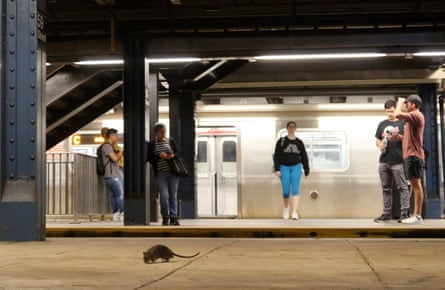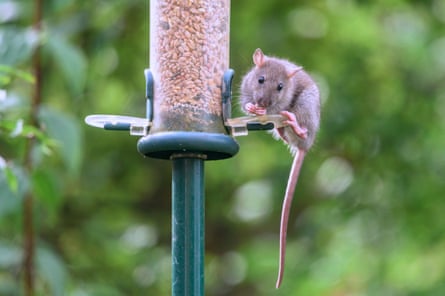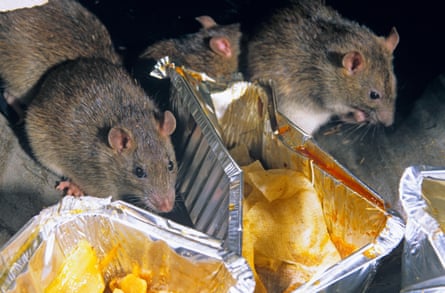Humans and rats have lived alongside each other for millennia. When humans started settling and growing ancient wheat and legumes, the local rats celebrated. “We were growing food that a lot of rodents like to eat,” says Steven Belmain, a professor of ecology at the University of Greenwich and a rat expert. “That started the semi-domestication of rats. I wouldn’t call them domestic, like you would cats or dogs, but they got quite used to humans. We produce excellent accommodation and food resources.”
When we created cities, the rats came with us. Now, they had concentrated access to our food and waste, as well as nice places to live. Sewers brought even more riches. Wild rats wouldn’t necessarily choose to eat human waste, but since it’s there in abundance in the safe, dark sewers in which they dwell, the urban rat thinks it might as well. There is a co-evolution, says Belmain, between rats and human civilisation.
Now, with funding-strapped councils reducing bin collections across the UK, in some cases considering reducing them to every three weeks, rats are thriving. The British Pest Control Association has reported a 115% increase in people seeking advice on controlling rats in the past three months. In New York, meanwhile, the situation is so dire that the city hired a “rat tsar” in April to try to stem the population. “Many of us live in communities where rats think they run the city,” said the mayor, Eric Adams.
It is worth remembering, says Bobby Corrigan, an urban rodentologist, that the medical research for which rats have been used may have added 30 to 40 years to humans’ lifespans. “We owe them a lot,” he says. “Yet nobody cares to say thanks to the rat.” True, they carry more than 50 recognised diseases – some of them serious – but humans tend not to be afflicted by them. “If it was easy for them to transmit those diseases, most of us in cities around the world would be sick all the time,” says Corrigan. Pity the 48 people who were hospitalised in England in 2022-23 because of a rat bite; the rest of us co-exist with rats quite happily, or at least unwittingly.
Perhaps it is time to get to know them a little better. Here, then, is what an average day in the life of a rat looks like.
Wakey-wakey!
The brown rat (Rattus norvegicus), known as the Norway rat, is the most common. It is believed to have originated in China and central Asia and was introduced to the UK in the 18th century. The black rat (Rattus rattus), far rarer in Britain, is the one that was blamed, perhaps unfairly, for the Black Death.
There are an estimated 80 million brown rats in the UK, although nobody really knows. They are active at night, says Belmain, with the peaks being dawn and dusk. “When you see rats during the day, it’s usually because there’s something upsetting them, or they’re very hungry,” he says. They are most likely to be young rats, who “come out in the day to avoid being harassed by the older individuals in the colony”. Rat sightings went up during the Covid lockdowns – closed restaurants and empty town centres meant food sources disappeared, so rats were forced to look for things to eat at all hours.
Nosing around
In suburbs, rats can live in gardens and on patches of ground such as railway tracks. “The places where you would find foxes you would also find rats,” says Belmain. In urban areas, many rats live in sewers. “They rarely come out, because the sewers are more or less closed systems. A lot of them live down there their whole lives.”
Others colonise alleyways or buildings. They can get into your home through holes – a broken air brick, for instance – or sewer pipes, emerging through your lavatory. “Which is, of course, very unpleasant,” says Belmain, with comical understatement.

They will make a home in the cavities of walls, roof spaces and under floorboards. In shops and offices, the ducting and voids in ceilings and walls are perfect spots. “They use this as a means of getting around,” says Belmain.
Corrigan has worked as a rat control consultant in New York, where he has seen them come out of cracks in the pavement. Leaving rubbish in bags on the streets means “we feed the rats all night long”, he says. Rats also like to live in parks: “They burrow into the soil. I’m sure you’ve seen rat holes.” Ultimately, they can live successfully in all manner of spots. “That’s why they’re so successful and so persistent,” he says. Belmain agrees – he has heard of rats living in freezers and coalmines, where miners drop scraps of sandwiches and other food. “They will adapt to amazingly different environments that are really quite harsh,” he says.
Breaking and entering
A small hole is no problem for a big rat. “They can gnaw to make it big enough for them to get in,” says Belmain. Their teeth are super strong and very sharp. “Their incisors grow all the time, so they have to gnaw to stop them from getting too big. They can chew through a lot of soft metals – lead, tin, aluminium.” They can even chew through concrete.
Snack time!
In their natural habitats, most rodents thrive on grains and seeds, but urban rats will eat virtually anything. Generally, though, “rodents are very clean, hygienic animals; they don’t want to live in the dirt and eat dirt. But they do if that’s all that is around,” says Belmain.
Do they have preferences? The freezer rats Belmain mentioned lived off the fat of frozen animal carcasses. “In that situation, they need a huge amount of energy to survive. But, generally, their preference will still be cereal grains,” he says, such as discarded burger buns or takeaway rice dishes. “A lot of it will be influenced by their environment.”

On Belmain’s allotment, the rats help themselves to organic vegetables. “But if they were in an urban area and there was a lot of rubbish around – chicken wings, chips – they would eat it.” They might feast on beetles or caterpillars, but they don’t hunt mammals; they don’t have canine teeth. They will eat dead meat, however, including cannibalising other rats. “You will hear anecdotes of rats attacking cats. That’s just because they’re defending themselves. They’re not going off on coordinated hunts for mice or anything. But if they found a dead mouse, they would certainly eat it.”
Engaging in some free loving …
“It’s a free-for-all,” says Corrigan of a rat’s healthy sex life. “There’s a sex ratio of one to one, male and female, which makes it very easy. When they’re out foraging, they tend to smell each other – a female is very attracted to the smell of a dominant male.” And it is fast, he says: “It’s over in seconds and, most of the time, it’s not a successful copulation. So they’re always hooking up, if you will, to make sure there will be some success.”
Rats will make a nest, which is where females give birth. “That will usually be a hole in the ground, but it could be in your compost heap or on the surface of the ground if there’s a lot of vegetation around – you can find a nest deep in a bush,” says Belmain. “If it was in a house, it could be in your cavity walls.”
… or popping out some pups
As soon as a female gives birth, she is ready to mate again and can get pregnant. Theoretically, then – in a good environment, with lots of food – she could conceive every 25 days or so. The nursing and weaning period for her young – six to 12 pups a litter – is about the same time as gestation, says Belmain. “Then they go off into the world and the next day she’s giving birth again. That’s why rats can get to such extraordinary numbers.”
It doesn’t sound much fun, but in reality it is not so relentless. Although they can breed year-round, “there will still be a cycle”, says Belmain. “In winter, there won’t be quite so much breeding. In spring, there will be an uptick that continues through the summer.”
Time to work (or play)
Rat numbers depend on resources. “Sometimes, it’s one rat eking out a living in somebody’s property, but more often than not, as long as there’s food, they will keep increasing their numbers,” says Corrigan. A single family of rats – typically a male, several females and younger rats – numbers about 10. “Then multiple families end up being a colony. You can have 200 to 300 on a city block, as long as there’s plenty of food. If there’s only enough food for 25 rats on that block, there’ll be 25.”

Rats can be social, he says. While studying for his PhD, Corrigan spent a year’s worth of weekends sleeping in a barn in Indiana to observe rats. “I saw mutual grooming. They have kindness in addition to aggression. They can be altruistic; they’ll carry a piece of food and share with another rat that’s not as healthy. They have a whole social structure.” Is that the same for a toughened city rat? “Yes and no,” he says. “Again, it gets down to resources.”
There will be some “training”, says Belmain. Mother rats will show their young where to look for food, but most rats are competitive and don’t share. Without wanting to anthropomorphise, Belmain says “rodents are not very sympathetic towards each other”. They use the space in their mouth for hoarding, “so they can fill their cheeks and take food elsewhere”. Pet rats can be playful, but Belmain says urban rats are more concerned with looking for food and mates and avoiding being eaten: “It’s too risky, essentially.”
A bit of daydreaming
There is evidence that rats have an imagination – a study published last year showed that they can navigate using just their thoughts. “Rats can recall places they’ve been,” says Corrigan. In lab studies, rats can do well in cognitive tasks. In the wild, though, says Belmain, there isn’t evidence of observing, processing and remembering. “If, say, a rat was caught in a trap, other rats wouldn’t learn anything about avoiding traps.” In fact, he adds, they would just eat the poor rat.
We do know, though, that they learn not to eat something if it makes them feel ill almost immediately, such as rat poison. “Rodents cannot vomit, so they’re cautious about what they eat,” says Belmain. This is why longer-acting anticoagulants are more successful as a poison. “But that has made so many problems, because these poisons accumulate in the environment.”
Sending out some wee signals
Rats use their urine and faeces in many ways, says Corrigan. It can be a signal to other rats, “like a community bulletin board. Sometimes, if a rat in a city finds a really good yard with trash everywhere, they will put down a lot of droppings over a couple of days,” to tell others to join it. Don’t they dislike competition? “There is a lot of territoriality, but if there’s a lot of food, they will tolerate one another.”
Time for a fight
During the pandemic, when food was scarce, Corrigan walked around New York doing rodent surveys. “I saw rats going to war – two colonies of rats in the middle of an alleyway fighting over one garbage can – and it was vicious,” he says. Usually, disputes end quickly – a dominant male will nip another male, who will retreat. “But in prolonged battles, they will stand on their hind feet and box. They can tackle each other, like in a wrestling match. There is lots of squealing.” If a rat is killed, the victors might eat it.
Going exploring

It isn’t well understood how big rats’ territories are, says Belmain. “In urban situations, they will find areas where they go 500 metres from the burrow, but most of the time they’re probably staying within 50 metres.” Sewer rats are thought to travel further than rats that live above ground.
Humans? What humans?
Some of our night-time behaviours – street lights and brightly lit offices, for instance – probably don’t have much of an impact on rats, says Belmain. “There have been some studies on wild rodents that are affected by that, as are many species, but generally rodents don’t have great vision. Their senses of smell, hearing and touch – their whiskers – are much more effective in nocturnal environments.” Also, they have become used to people. “Often, they don’t run away when they see a human; they just sit there,” says Belmain.
Contemplating mortality
“If life is really good – let’s say they live in an alleyway and nobody bothers them – if they get a year, they’re happy,” says Corrigan. “The average rat in a city lives seven to nine months. If you take that same rat from a pup and you put it in a cage and take care of it like a pet, you can get up to three years. But that’s not the life of a city rat.”
Time for bed
After all that eating, mating and fighting (and possibly exploring), the sun will be coming up; it is time for sleep. “That’s one reason why we don’t notice them much,” says Belmain. But remember: it will all start again tonight.
